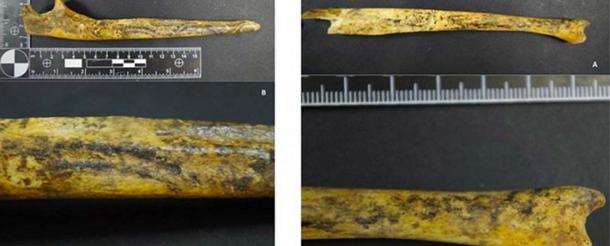
Carved Bones Surface Belonging to a Very Special Woman
A Polish-Ukrainian team of archaeologists digging in an earthen barrow in central Dniester, now Ukraine recently unearthed something they've never seen before: the bones of 25-30-year-old woman, buried 4,500 years ago, decorated with intricate black markings.
In a new research paper being published in the upcoming issue of Baltic-Pontic Studies, Archaeologist Danuta Żurkiewicz from the Institute of Archaeology and Adam Mickiewicz University in Poznań told Science in Poland, "While drawing and photographing the burial, our attention was drawn to regular patterns, such as parallel lines visible on both elbow bones.”

Distinct black marks found on the bones. (Image: © Danuta Żurkiewicz, Science in Poland)
Where casual observers might have been tempted to assume these were manmade marks, the archeologists applied caution because they suspected that the marks might have been left by animals. However, chemical analysis of the bone markings revealed that they had been made ¨deliberately, by another human, using a black substance, similar to wood tar.”
Way past post-mortem markings
Adding to this mystery, the marked bones were not executed just after her death, but a long time after her body had decomposed indicating her grave had possibly been reopened for the markings to have been applied. If this is indeed what happened, then after the bones had been marked they had been carefully re-laid ¨in anatomical order¨ before the body was buried again. Speaking to reporters of this, Żurkiewicz said, "It is surprising that the procedure of decorating the bones had to be done after death and the process of body decomposition. This is clearly indicated by the location of the decoration on the bone surface and the way dye was applied.”
- Human Bone Daggers in New Guinea were Used to Strike the Fatal Wound
- China Offers $15,000 for Each Deciphered Character of Mystery Text on Ancient Oracle Bones
- Prehistoric Britons Cannibalized Dead Relatives and Created Art with their Bones

The female skeleton was found in Dniester, Ukrain in 2016. (Danuta Żurkiewicz/Adam Mickiewicz University)
Without comparison
Similar marks have been found on bones elsewhere in Europe, but they are all interpreted as having been made by tattoos, and these bones are the first to have been discovered treated in this particular manner, anywhere. In Buddhist Tantric traditions, human bones were fabricated into ritual tools and instruments which were considered important in reminding of the impermanence of life. Practitioners meditating upon this better realize that their existence will also be reduced to a small pile of bones, a concept which is also important in Theravadin traditions, in which skeletons are often displayed to remind monks of the transience of life and the impermanence of all material forms. In Tibet, human bones were important because of the lack of wood, and almost all wood had to be imported from India by yaks. Wood was of course used to build temples and for making wooden blocks to print sacred texts, but human bone was decorated by artisans to create sacred objects.
A MET Museum article tells us that on the other side of the world, Maya art was born from the interaction between societies in the Yucatan Peninsula and those of the Mexican Gulf Coast, known as the Olmec civilization. In the first millennium BC, Maya artists sculpted in stone, stucco, wood, bone, shell, and fired clay and, ¨during the Classic Period (ca. 250–900 AD), rulers of powerful city-states such as Tikal, Calakmul, Palenque, and Copán, commissioned artworks to cover their royal court buildings and their regal bodies.¨ Jade sculpted deity figures were crafted into amulets and beads, which were worn by rulers, and deposited in their funerary chambers while hard stones were also cut and incised with both marine and freshwater shells, animal bones, and even human bones.
But nothing has ever been found even resembling this recently discovered woman bones in Ukraine.
- Jawbone Jewelry: Archaeologists Discover 1,300-Year-Old Painted Bone Pendants in Mexico
- 12,300-Year-Old Bone Pendants May be Oldest Artwork Ever Discovered in Alaska
- Surprising Stone Age Knowledge Revealed on a Mammoth Bone Bracelet
A special find
Because of the uniqueness of her burial, the researchers believe she must have been regarded as special in some way. Archaeologists know that these nomads were constantly on the move wandering across landscapes with their carts and animals, with no permanent settlements.
However, although they never settled, they did place a great importance on burials of their dead and left several thousands of burial mounds called Kurgans - indicating that their funerary practices were a central component in their culture. Adding to the questions surrounding this woman and her mysteriously marked bones, relatively few of the burial mounds have been found to contain the remains of women. Therefore, whoever she was, concluded Żurkiewicz, ¨the deceased, whose bones were covered with patterns, had to be an important member of the community," .
Top image: Source: Danuta Żurkiewicz/Adam Mickiewicz University
By Ashley Cowie
















Comments
Maybe she was a witch and those markings were to keep her from attacking after her life? I am sure that they Mayans had shamans, so maybe they had negative entities with magical powers. Maybe they didn't call her a witch, but some Native American tribes had witch lore.